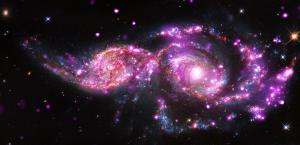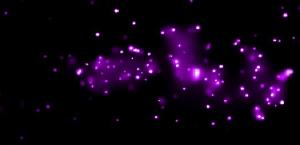Blog
Light It Up
16 December 2014
 X-ray: NASA/CXC/SAO/S.Mineo et al, Optical: NASA/STScI, Infrared: NASA/JPL-Caltech
X-ray: NASA/CXC/SAO/S.Mineo et al, Optical: NASA/STScI, Infrared: NASA/JPL-CaltechThe image shows two colliding galaxies known as NGC 2207 and IC 2163.1 It’s a false-color image, where infrared is shown as dark red, visible is shown as normal, and x-ray is shown as purple. The first impression you might have is that the image looks awfully purple, and that means there are lots of x-ray sources in these two galaxies.
The reason for this is that the two galaxies are colliding. Young galaxies tend to have lots of gas and dust around to make stars, so they can produce stars at a fairly high rate, such as we see in dusty starburst galaxies. But over time the rate of stellar production goes down as the free gas and dust tends to get used up. In the Milky Way, for example, new stars form at a rate of only 1 or 2 a year.
 NASA/CXC/SAO/S.Mineo et al
NASA/CXC/SAO/S.Mineo et alIn these galaxies that rate is about 24 solar-mass stars per year. We know this because of the high number of ultraluminous x-ray sources (ULXs), seen as bright violet dots within the image. The stars associated with these sources are only about 10 million years old, and such sources don’t stay bright for long on astronomical scales.
Images such as this further support what we’ve long thought, that galaxy collisions can stir up star production in galaxies.
Mineo, S., et al. “A Comprehensive X-Ray and Multiwavelength Study of the Colliding Galaxy Pair NGC 2207/IC 2163.” The Astrophysical Journal 797.2 (2014): 91. ↩︎